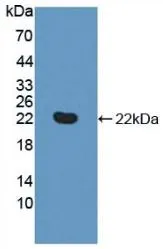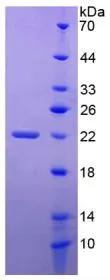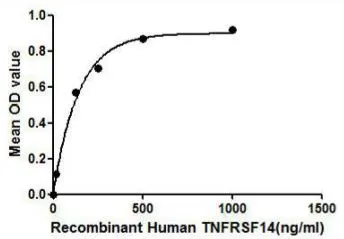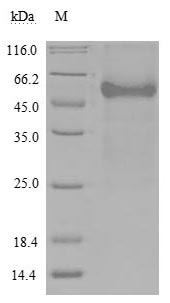
WB analysis of GTX00145-pro Human TNFRSF14 protein.
Human TNFRSF14 protein, His tag
GTX00145-PRO
ApplicationsFunctional Assay
Product group Proteins / Signaling Molecules
Protein IDQ92956
Overview
- SupplierGeneTex
- Product NameHuman TNFRSF14 protein (active)
- Delivery Days Customer9
- Application Supplier NoteTNFRSF14 (Tumor necrosis factor receptor superfamily member 14) belongs to the tumor necrosis factor receptor superfamily. TNFRSF14 functions in signal transduction pathways that activate inflammatory and inhibitory T-cell immune response. It binds herpes simplex virus (HSV) viral envelope glycoprotein D (gD), mediating its entry into cells. A binding ELISA assay was conducted to detect the association of TNFRSF14 with TNFa. Briefly, TNFRSF14 were diluted serially in PBS, with 0.01% BSA (pH 7.4). Duplicate samples of 100 microl TNFRSF14 were then transferred to TNFa-coated microtiter wells and incubated for 2h at 37C. Wells were washed with PBST and incubated for 1h with anti-TNFRSF14 pAb, then aspirated and washed 3 times. After incubation with HRP labelled secondary antibody, wells were aspirated and washed 3 times. With the addition of substrate solution, wells were incubated 15-25 minutes at 37C. Finally, add 50 microl stop solution to the wells and read at 450nm immediately. The binding activity of TNFRSF14 and TNFa was in a dose dependent manner.
- ApplicationsFunctional Assay
- CertificationResearch Use Only
- ConjugateUnconjugated
- Protein IDQ92956
- Protein NameTumor necrosis factor receptor superfamily member 14
- Scientific DescriptionThis gene encodes a member of the TNF (tumor necrosis factor) receptor superfamily. The encoded protein functions in signal transduction pathways that activate inflammatory and inhibitory T-cell immune response. It binds herpes simplex virus (HSV) viral envelope glycoprotein D (gD), mediating its entry into cells. Alternative splicing results in multiple transcript variants. [provided by RefSeq, Jul 2014]
- Storage Instruction-20°C or -80°C,2°C to 8°C
- UNSPSC12352202





